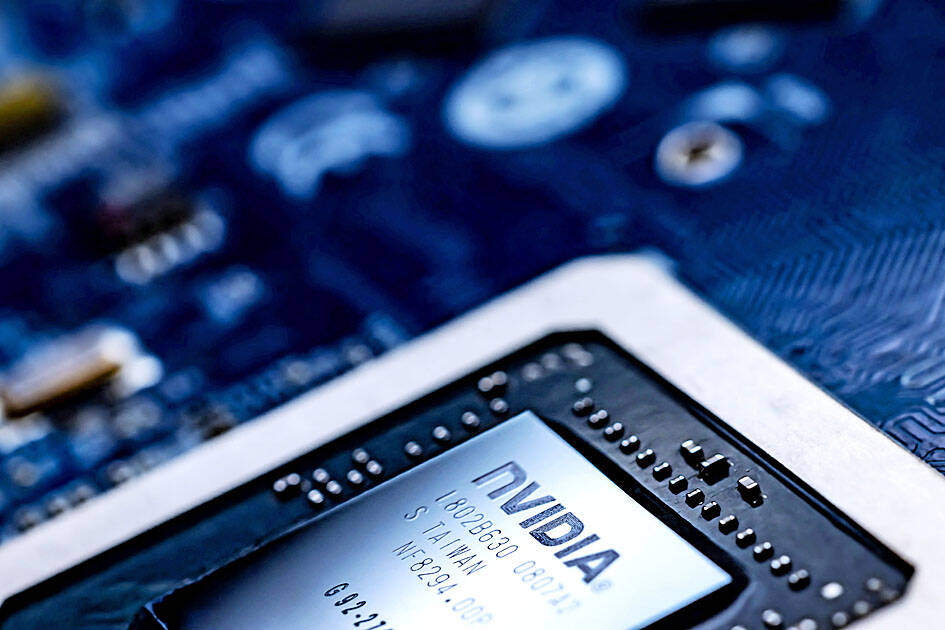Nvidia Corp on Wednesday overshot Wall Street estimates, as its profit skyrocketed bolstered by its dominance in chipmaking, which has made the company an icon of the artificial intelligence (AI) boom.
Its net income rose more than sevenfold from US$2.04 billion a year earlier to US$14.88 billion in its first quarter. Revenue more than tripled from US$7.19 billion the previous year to US$26.04 billion.
“The next industrial revolution has begun,” Nvidia CEO Jensen Huang (黃仁勳) said on a conference call with analysts.

Photo by Joel Saget, AFP
Companies buying Nvidia chips would use them to build a new type of data center, designed to produce a new commodity: AI, Huang said, calling them “AI factories.”
Training AI models is becoming a faster process, as they learn to become “multimodal” — that is, capable of understanding text, speech, images, video and 3D data — and able to “reason and plan,” Huang added.
The company reported earnings per share — adjusted to exclude one-time items — of US$6.12, well above the US$5.60 that Wall Street analysts had expected, FactSet said.
Nvidia also announced a 10-for-1 stock split, a move that it said would make its shares more accessible to employees and investors.
The company increased its dividend from US$0.04 a share to US$0.10.
Nvidia shares rose 6 percent in after-hours trading to US$1,006.89 on Wednesday. The stock has risen more than 200 percent in the past year.
The company now boasts the third-highest market value on Wall Street, behind only Microsoft Corp and Apple Inc.
“Nvidia defies gravity again,” Emarketer analyst Jacob Bourne said of the quarterly report.
While many tech companies are eager to reduce their dependence on Nvidia, which has achieved a level of hardware dominance in AI rivaling that of earlier computing pioneers such as Intel Corp, “they’re not quite there yet,” Bourne said.
Demand for generative AI systems that can compose documents, make images and serve as increasingly lifelike personal assistants has fueled astronomical sales of Nvidia’s specialized AI chips over the past year.
Tech giants Amazon.com Inc, Google, Meta Platforms Inc and Microsoft Corp have signaled that they would need to spend more in coming months on the chips and data centers needed to train and operate their AI systems.
What happens after that could be another matter.
Some analysts believe that the breakneck race to build those huge data centers would eventually peak, potentially spelling trouble for Nvidia in the aftermath.
“The biggest question that remains is how long this runway is,” Third Bridge analyst Lucas Keh said.
AI workloads in the cloud would eventually shift from training to inference, or the more daily task of processing fresh data using already trained AI systems, Keh said.
Inference does not require the level of power provided by Nvidia’s expensive top-of-the-line chips, which would open up market opportunities for chipmakers offering less powerful, but also less costly, alternatives, Keh added.
When that happens, “Nvidia’s dominant market share position will be tested,” Keh said.

GROWING OWINGS: While Luxembourg and China swapped the top three spots, the US continued to be the largest exposure for Taiwan for the 41st consecutive quarter The US remained the largest debtor nation to Taiwan’s banking sector for the 41st consecutive quarter at the end of September, after local banks’ exposure to the US market rose more than 2 percent from three months earlier, the central bank said. Exposure to the US increased to US$198.896 billion, up US$4.026 billion, or 2.07 percent, from US$194.87 billion in the previous quarter, data released by the central bank showed on Friday. Of the increase, about US$1.4 billion came from banks’ investments in securitized products and interbank loans in the US, while another US$2.6 billion stemmed from trust assets, including mutual funds,

AI TALENT: No financial details were released about the deal, in which top Groq executives, including its CEO, would join Nvidia to help advance the technology Nvidia Corp has agreed to a licensing deal with artificial intelligence (AI) start-up Groq, furthering its investments in companies connected to the AI boom and gaining the right to add a new type of technology to its products. The world’s largest publicly traded company has paid for the right to use Groq’s technology and is to integrate its chip design into future products. Some of the start-up’s executives are leaving to join Nvidia to help with that effort, the companies said. Groq would continue as an independent company with a new chief executive, it said on Wednesday in a post on its Web

Even as the US is embarked on a bitter rivalry with China over the deployment of artificial intelligence (AI), Chinese technology is quietly making inroads into the US market. Despite considerable geopolitical tensions, Chinese open-source AI models are winning over a growing number of programmers and companies in the US. These are different from the closed generative AI models that have become household names — ChatGPT-maker OpenAI or Google’s Gemini — whose inner workings are fiercely protected. In contrast, “open” models offered by many Chinese rivals, from Alibaba (阿里巴巴) to DeepSeek (深度求索), allow programmers to customize parts of the software to suit their

JOINT EFFORTS: MediaTek would partner with Denso to develop custom chips to support the car-part specialist company’s driver-assist systems in an expanding market MediaTek Inc (聯發科), the world’s largest mobile phone chip designer, yesterday said it is working closely with Japan’s Denso Corp to build a custom automotive system-on-chip (SoC) solution tailored for advanced driver-assistance systems and cockpit systems, adding another customer to its new application-specific IC (ASIC) business. This effort merges Denso’s automotive-grade safety expertise and deep vehicle integration with MediaTek’s technologies cultivated through the development of Media- Tek’s Dimensity AX, leveraging efficient, high-performance SoCs and artificial intelligence (AI) capabilities to offer a scalable, production-ready platform for next-generation driver assistance, the company said in a statement yesterday. “Through this collaboration, we are bringing two